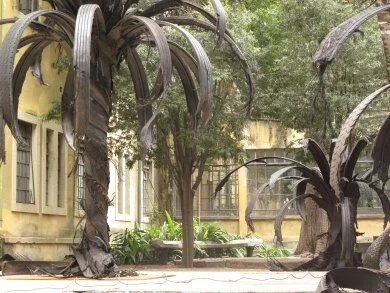Arvore! A tragédia da paisagem | Praca Adolpho Bloch, Sao Paolo
The exhibition “Arvore! A tragédia da paisagem” is the first exhibition by the Circular Project – Art in Praça Adopho Bloch – Sao Paulo. The collection highlights the concern for the natural world. “The specially selected artists chose to either focus on the theme of the trees themselves, whilst others invite the viewer to sit down and enjoy the beauty of the Adolpho Bloch square or send positive messages of hope for a future world where Nature’s salvation will be more assured or transformed.”
‘Nothing is lost, nothing is created, everything is transformed’
Douglas White seems to have taken these words of the chemist and agronomist, Antoine Lavoisier, as his motto. White’s artworks are grounded in a deep affinity for discarded objects, both natural and man-made, and his compulsion to transform them into something altogether stranger. The artist teases out meaning and power from the detritus of the every day in a practice which explores the aesthetic and narrative possibilities of materials that would otherwise be left to waste; lightning struck trees, exploded tyres, vandalised recycling bins, decaying cactus. The magical atmosphere emitted by White’s strangely compelling and poetic works, combined with his investigative spirit, reveals a passion for the curious, whatever its form.
‘In the tropical forest, when a palm becomes diseased, it is burned….’. During a residency in Belize, Central America in 2005, Douglas White was haunted by images of these charred figures, seeing echoes of their spectral figures in the strange twisted remains of exploded tyres that littered the country’s roadsides. In collecting and assembling these forms the artist weaves new and exuberant poetic possibilities from the remains of the everyday.
Constructed in the Belizean jungle, this first palm sculpture found itself in the heart of the natural world, a chemical stranger. Subsequent iterations saw White collect and ship the material from Belize to Europe, the narrative becoming a troubling monument to a European colonialism that at once fetishised the exoticism of tropical nature while at the same time using it as a standing reserve for its industry. In 1876 Henry Wickham returned from Brazil with a specimen of the Para Rubber tree, its sap rapidly developing into the worldwide rubber industry. This material’s disposal now constitutes a worldwide environmental concern. In transforming these tonnes of roadside waste the project begins to imagine an ideal circular economy, where waste becomes a new resource, and everything is transformed.
Exhibition: 31.08 - 15.12.2019
Artists: Cacipore Torres | Camille Kachani | Carlito Carvalhosa | Ciro Schu | Douglas White | Erika Malzoni | Felippe Moraes | Oskar Metsavaht | Vitche
Curator: Marc Pottier
